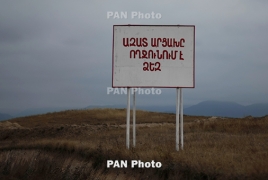Karabakh marks 25th anniversary of Shushi liberation May 8, 2017 - 12:43 AMT PanARMENIAN.Net - Nagorno Karabakh (Artsakh) is marking the 25th anniversary of Shushi liberation on Monday, May 8. Shushi was liberated on May 9, 1992. Liberation of Shushi was crucial because of its major strategic significance and had its decisive say in the further development of the National Liberation Movement. Constant bombings left the capital of Nagorno Karabakh in ruins, killing hundreds. From November 1991 up to the first half of 1992 over 4740 shells were fired at Stepanakert from Shushi, Djangasan, Kesalar, Gaibalu. As a result, 111 people were killed and 332 injured, 370 houses were left in ruins. Moreover, there was no connection with Armenia through the Lacin corridor. The blockade resulted in a lack of electricity, gas and dirking water, greatly damaging the economy of the whole republic. After a number of successful operations in late 1991 and early 1992, the liberation of Khojalu on February 25-26, 1992 and the opening of the airport created economic, military and physiological preconditions for liberation of Shushi. The self-defense of the village Karintak on 25-26 January of 1992 was of great significance, when the small detachment of the Armenian volunteers was able to resist the counterattack organized by the huge army of the enemy from Shushi. By April 27, 1992 in Shushi, from where the population was replaced, a huge number of military equipment was deployed. To liberate Shushi, the Armenian side took a number of diplomatic and decisive actions. The military operation was carried out on May 8 - 9. It was one of the greatest ones in the history of Armenia, bringing a radical turn in the course of military operations of the Karabakh Liberation Movement. The plan of actions was developed under the supervision of A. Ter-Tadevosyan right after Khodjalu was liberated. The plan was drawn in the moths of March and April, after the position, and the number of the enemy troops was clarified. The enemy forces were much larger in number. By April 28 the operation directions, the commanding officers and the availability of forces were already clarified. The attack was supposed to launch on May 4, but for a number of reasons (lack of ammunition, bad weather etc.) it was postponed. On the night of May 8, 4 attacking and 1 backup group of 1200 fighters launched the attack. The outcome of the military actions was already predetermined on May 8, when the subdivisions seized very favorable positions, with the enemy allowed to leave the city through the corridor. At noon, the enemy's first military plane and helicopters launched the attack. A number of Armenian units, as well as Shushi and Stepanakert were fiercely bombarded. Later it turned out that the aim of the air attack was liquidating of the few military ammunition depots left in Shushi, as well as the whole city; however, they failed. The Khazanchetsots Church, where the Azeris kept their ammunition depots, also survived. The operation was almost completed by the evening. On May 9 the ancient Armenian city was liberated. The foreign ministers of Armenia and Azerbaijan, Ararat Mirzoyan and Jeyhun Bayramov, have arrived in Washington. The CSTO budget for the current year requires adjustments due to the refusal of Yerevan to pay their share of contributions. Six total incidents have burned 19 old-growth trees. Friday night 8 trees were torched along the beautiful main entrance. The EU does not intend to conduct military exercises with Armenia, Lead Spokesperson for EU Foreign Affairs and Security Policy Peter Stano says. Partner news |